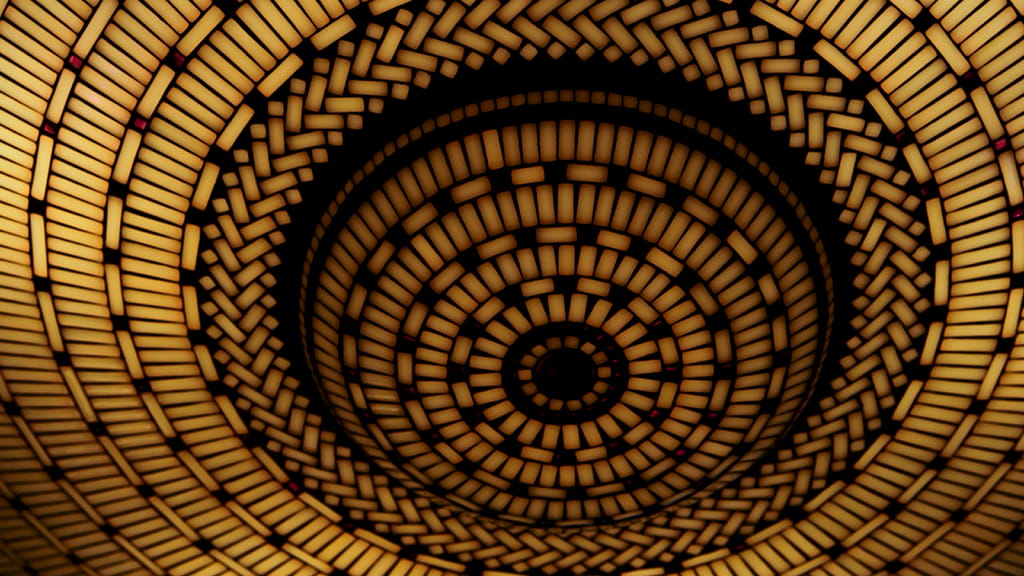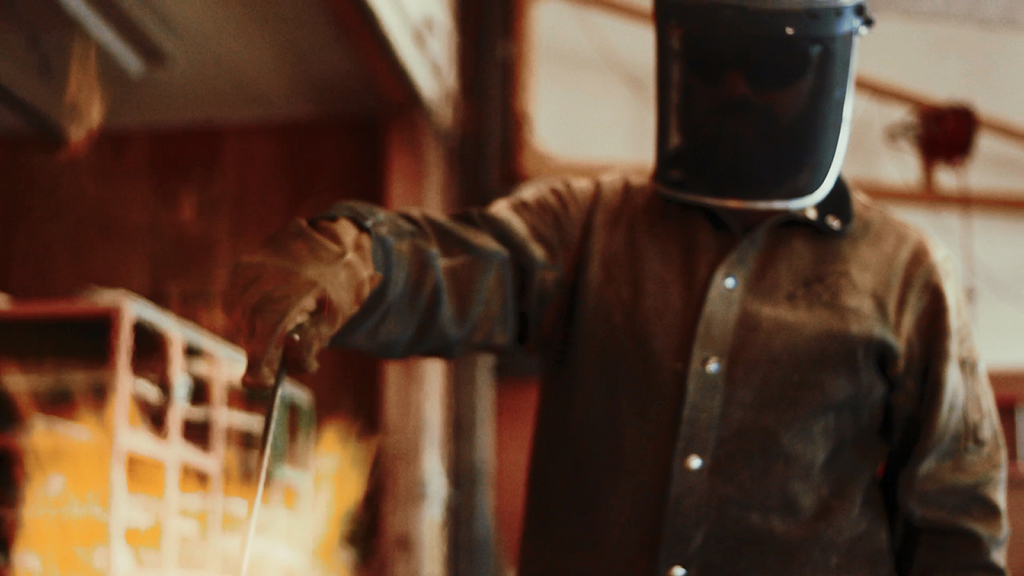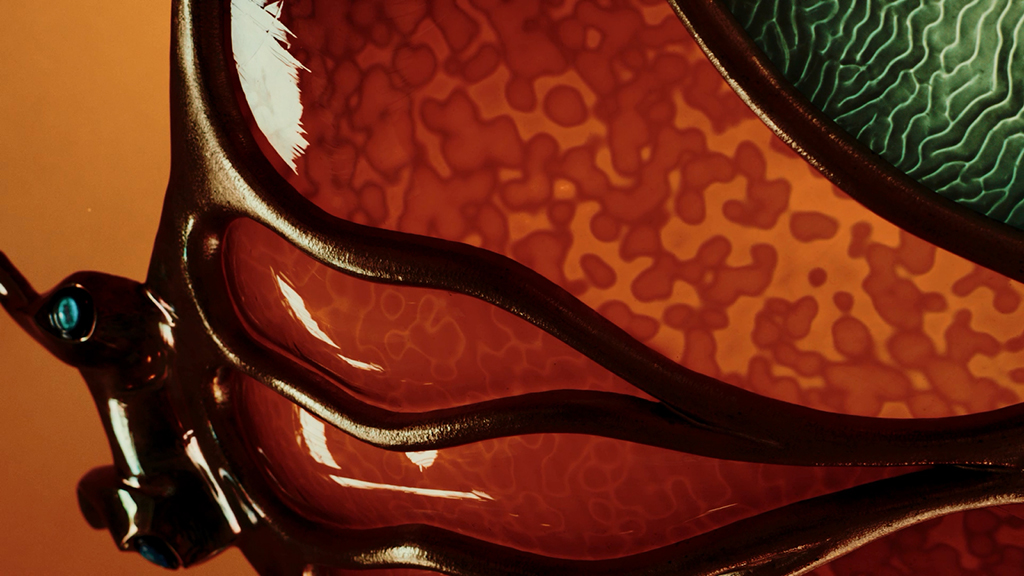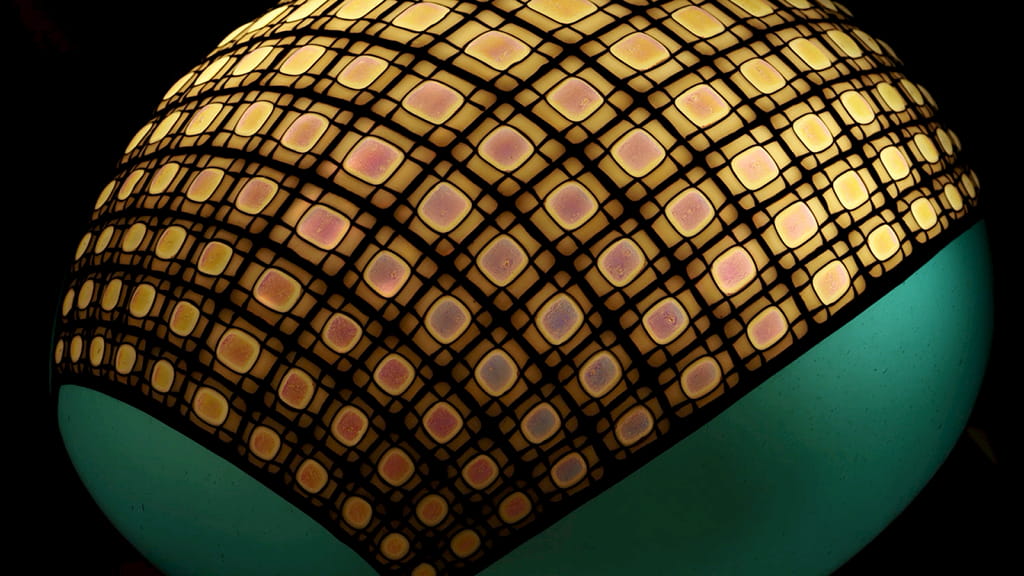CONSUME: CHEF / MAKER Talks
Starting with the opening afternoon of Consume: Handcrafting L.A. Restaurants, the Craft in America Center will be presenting talks between chefs and designers/makers that they have worked with. Check back as we add more talks throughout the run of the exhibition.
Please RSVP to events at rsvp@
Otium / Neptune Glassworks / Irving Place Studio
10/5/19, 3pm
At 3pm, please join the Craft in America Center for a talk with Chef Timothy Hollingsworth of Otium, Uri Davillier of Neptune Glassworks, and Sabrina Judge of Irving Place Studio on collaborating and how the handmade came to shape the look of Otium. The discussion will be moderated by the curator of the exhibition and Director of the Center, Emily Zaiden.
Event page: https://www.craftinamerica.org/event/consume-opening
n/naka / MANO YA
10/7/19, 7pm
This installment will feature Chef Niki Nakayama of n/naka and Design/Maker pair Zen Sekizawa and Mario Correa of MANO YA. This talk will be moderated by Center Coordinator and Assistant Curator Alex Miller.
Event page: https://www.craftinamerica.org/event/nnaka
auburn / Klein Agency / Humble Ceramics
10/24/19, 7pm
This talk will feature Chef Eric Bost of auburn paired with Jon and Masa Kleinhample of Klein Agency and Delphine Lippens of Humble Ceramics.
Event page: https://www.craftinamerica.org/event/auburn
Somni
12/9/19, 7pm
A talk with Chef Aitor Zabala of Somni about collaborating on dishes and the creative process behind the design of Somni and practices used in his cooking and plating.
Support for these programs provided by the Department of Cultural Affairs, City of Los Angeles, the Pasadena Art Alliance, and the Los Angeles County Arts Commission

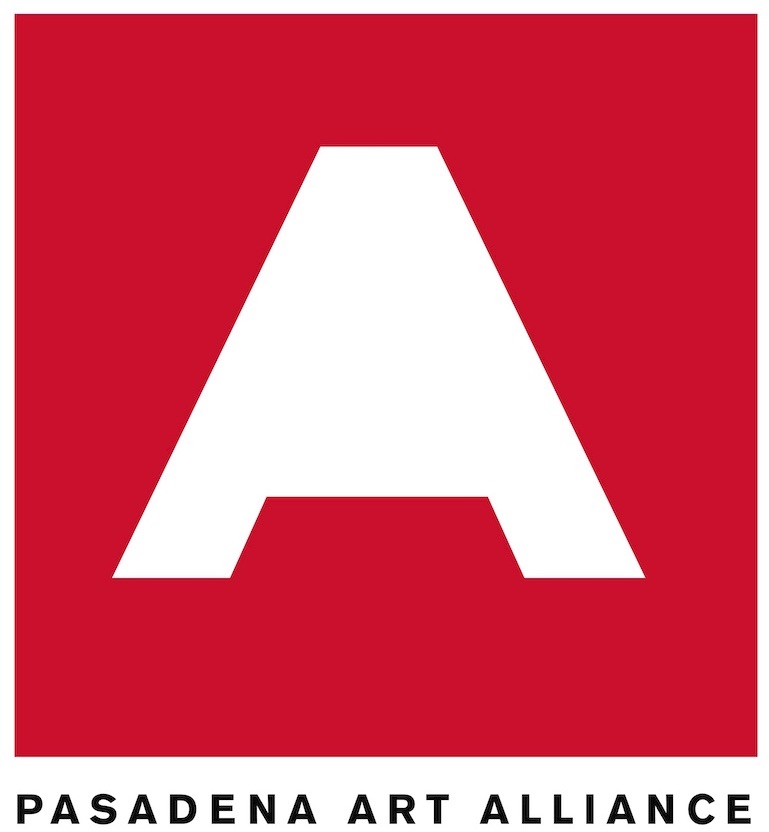

Susan Cummins Talk at the Center
This past Saturday, art jewelry advocate Susan Cummins walked a full house through the wearable artworks of Joyce J. Scott. As the former owner of a gallery that dealt in fine art jewelry, a collector, and now the director of the Rotasa Foundation, Cummins had a unique access point for Scott’s work.
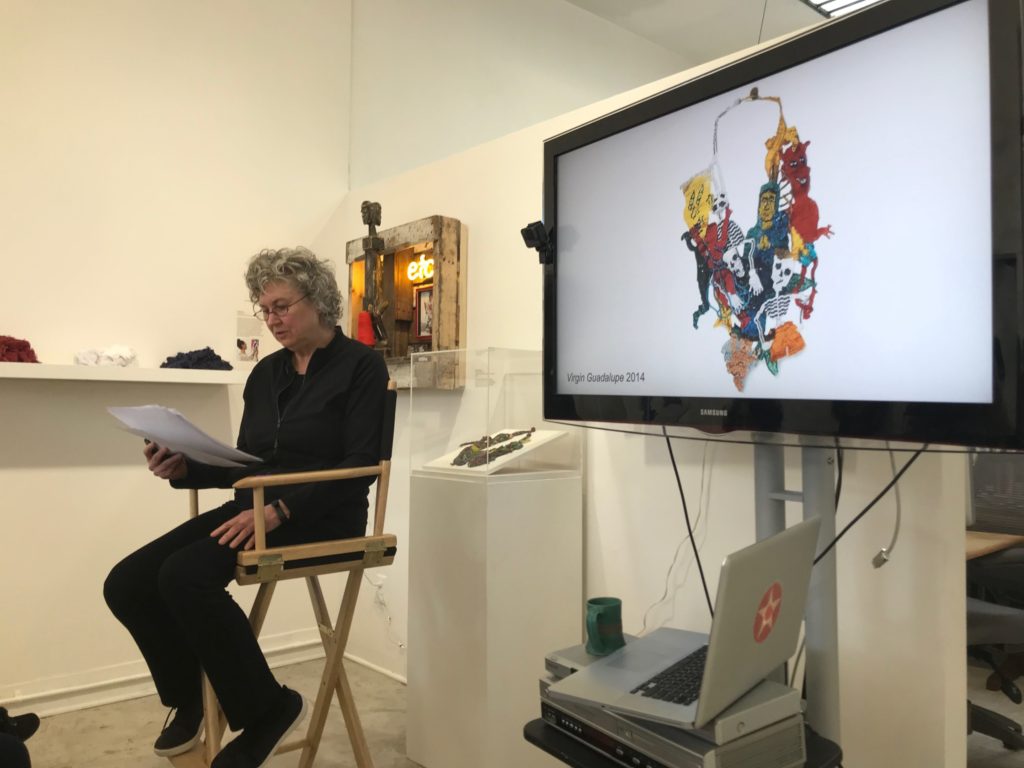
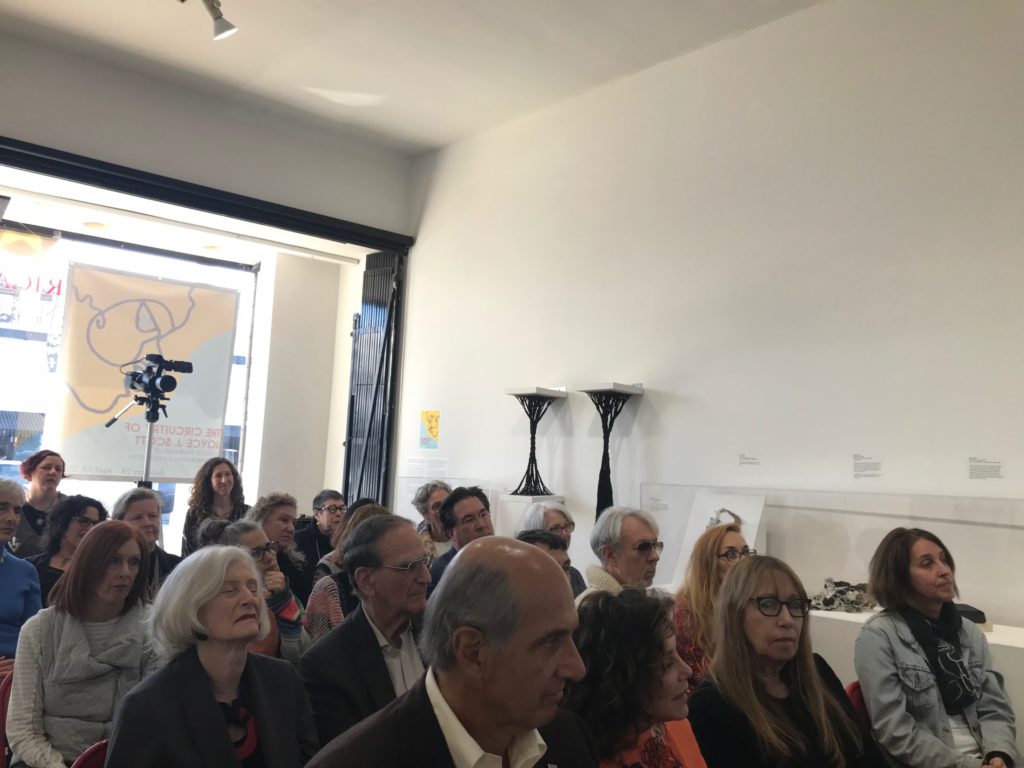
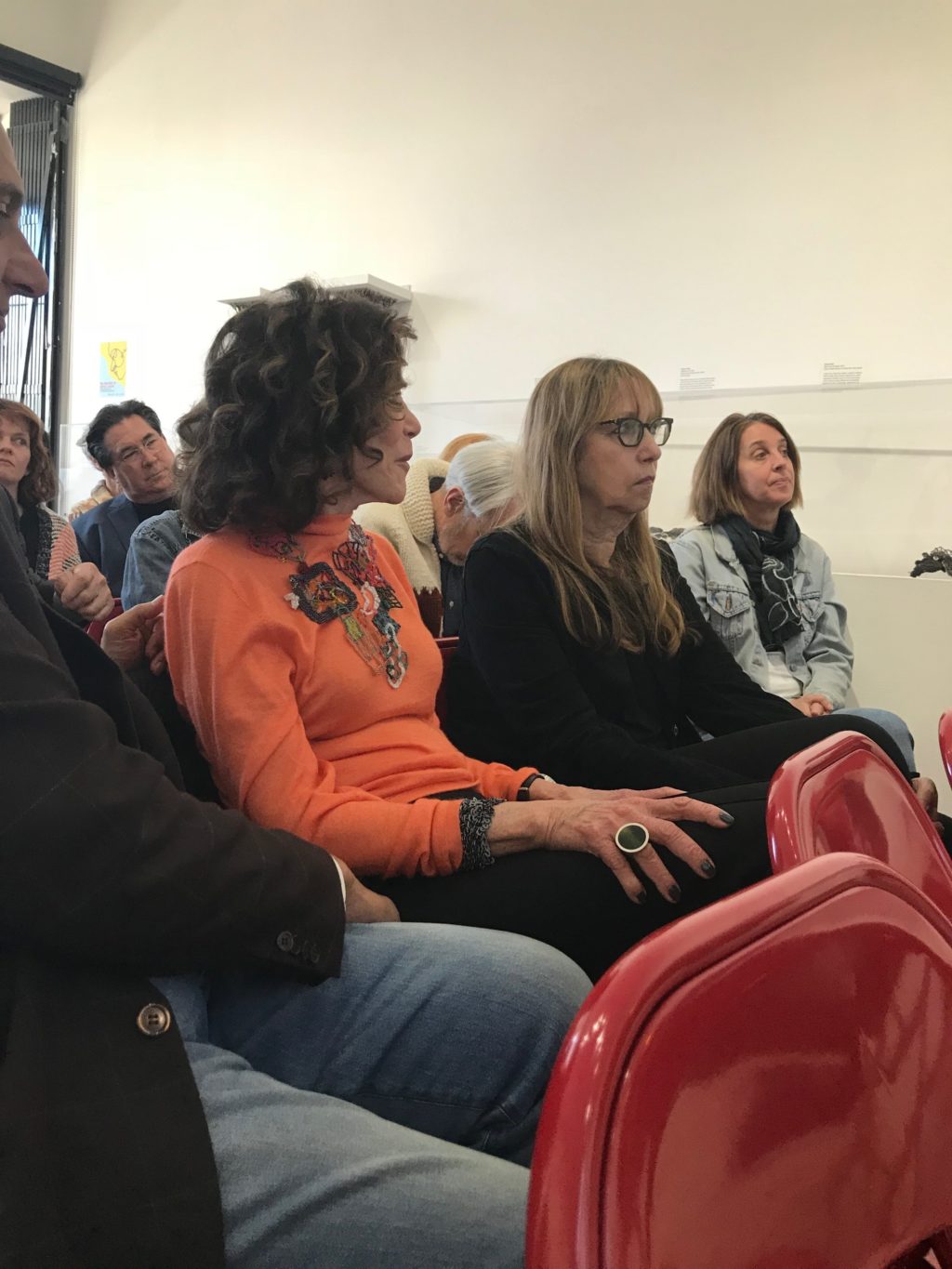
Cummins spoke specifically about four necklaces that are in The Circuitry of Joyce J. Scott: A Group Exhibition of Collaboration and Innovation. It was fantastic to hear about specific pieces and them to be able to point to them around the room.
As a lovely surprise, Shana Kroiz, who has a piece in Circuitry, was able to relate her personal connection to Scott and how she doesn’t believe that Scott gets any sleep because of how prolific she is. As another surprise, a member of the audience was actually wearing a Joyce J. Scott piece.
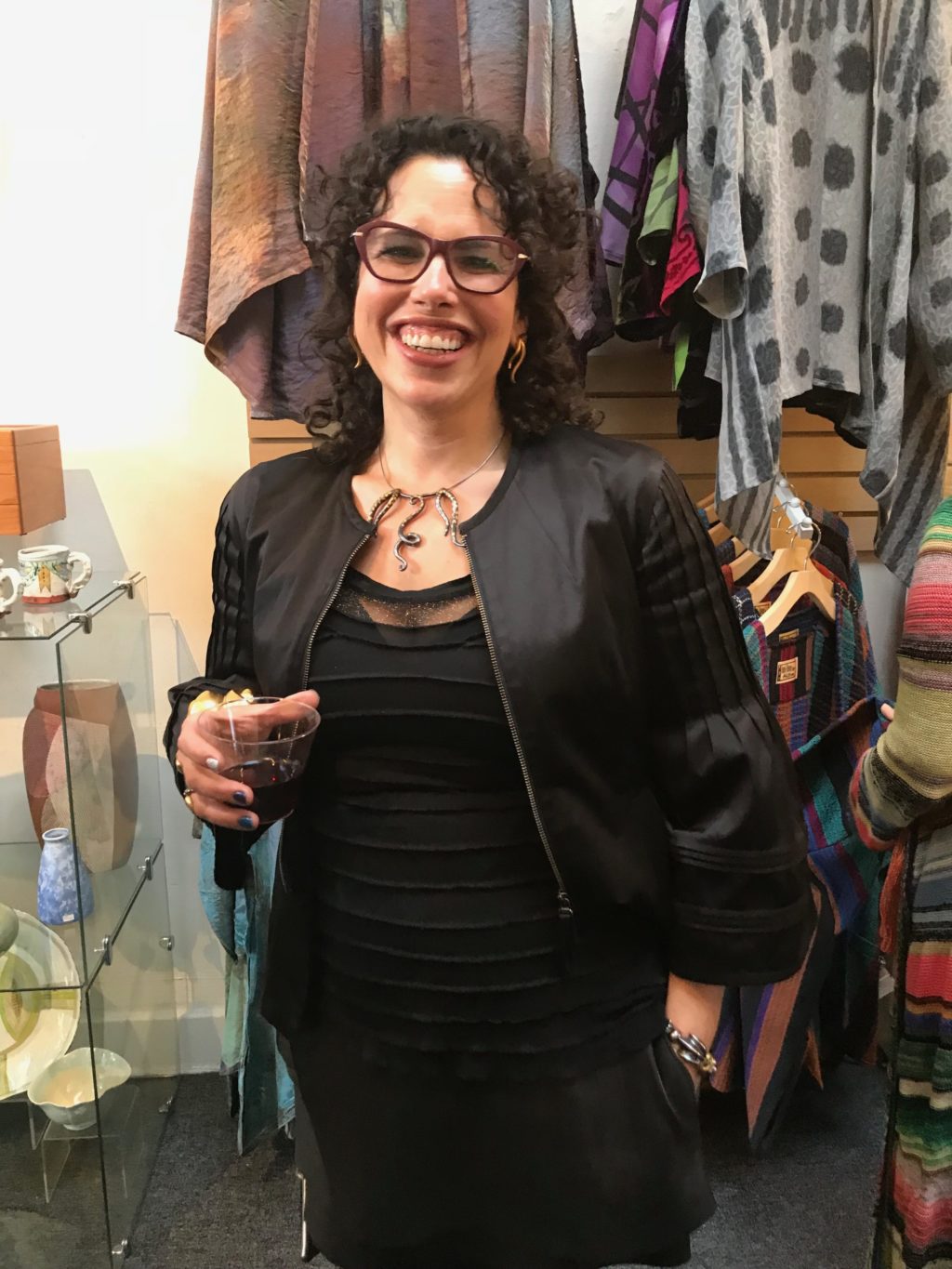
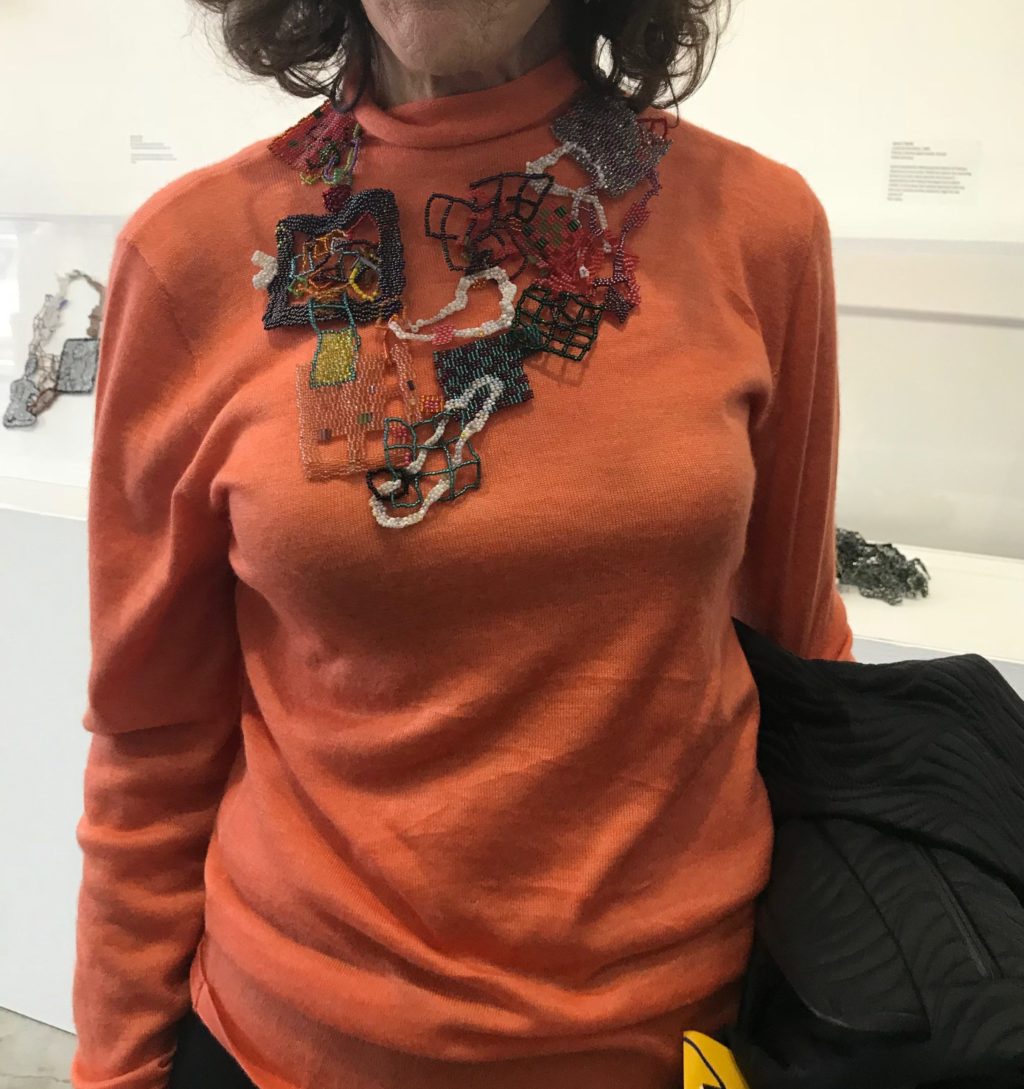
The talk will be available on craftinamerica.org soon.
Artist Talk: Gerardo Monterrubio
Today, artist Gerardo Monterrubio gave a heartfelt and thoughtful talk at the Center. It was a full house surrounded by his magnificent work.
It was remarkable how much we learned about the artist personally. While always referencing a piece of artwork, we were informed about his past via the drawings that adorn his sculpted objects. He mentioned that one of the things about working in 3D is beauty of imagery being able to wrap around.
During the talk, Gerardo talked about how he loves how glaze violates the form. It will run and move on the pieces unexpectedly. It might draw your attention to something you might not have noticed.
The talk will be available online to view soon. You can view all artist talks on our website at www.craftinamerica.org/talks
ARTIST TALK: JOY STOCKSDALE Joy Stocksdale’s talk
Fiber artist Joy Stocksdale was greeted with a warm reception on Saturday April 1 and she reciprocated by sharing with us her warmest memories while growing up. Joy began her presentation by showing us images of her as a child and of the home she grew up in. She explained how it was her father, mother and stepmother who influenced her to pursue a fiber career because of their own involvement in the arts and crafts; she knew from an early age that it was and still is possible to make a living by making things with your hands. Joy’s father, Bob Stocksdale, passed away 15 years ago and was a very successful and well-known wood turner. Joy wishes to continue his legacy and spirit in the crafts.
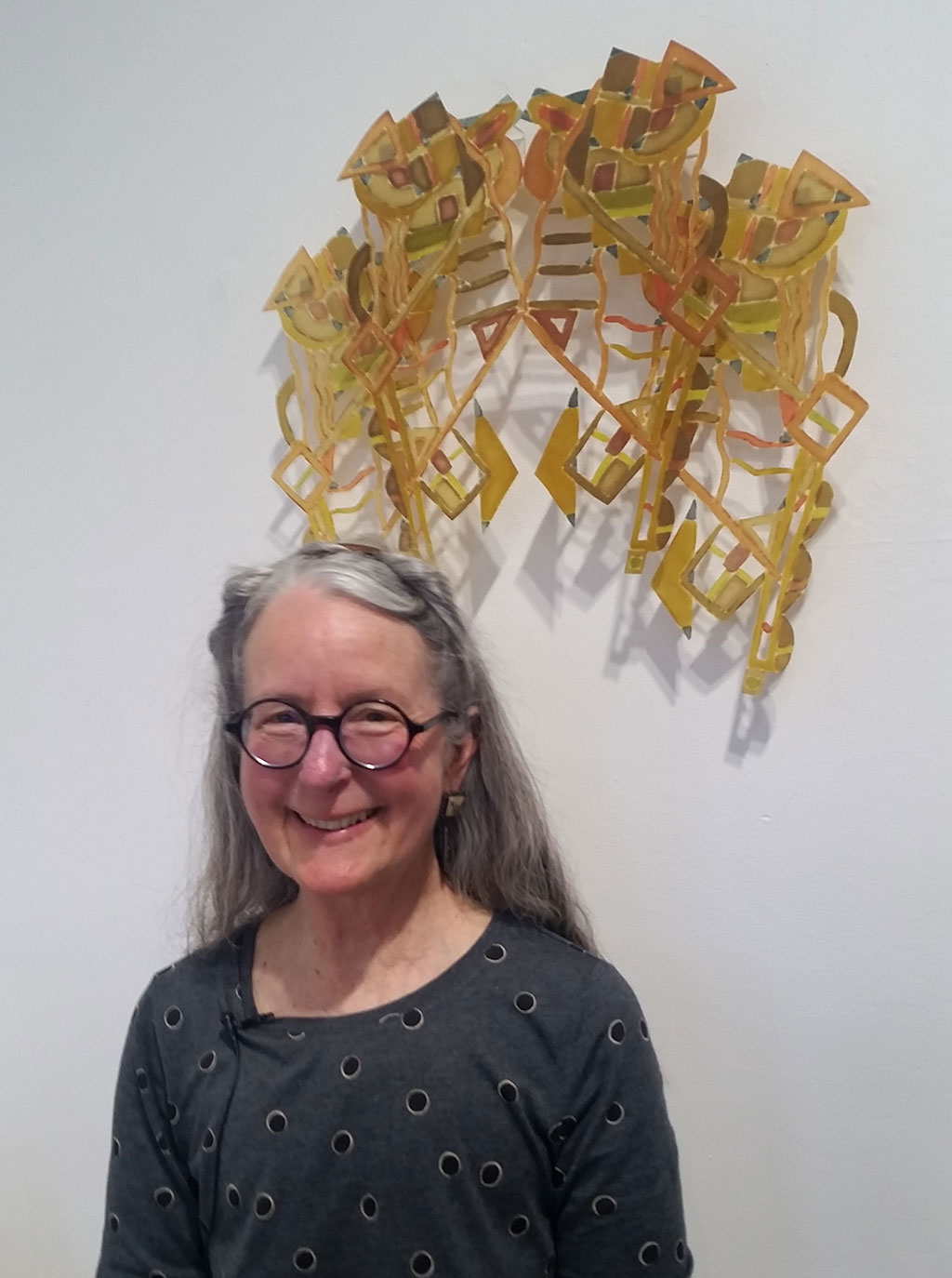
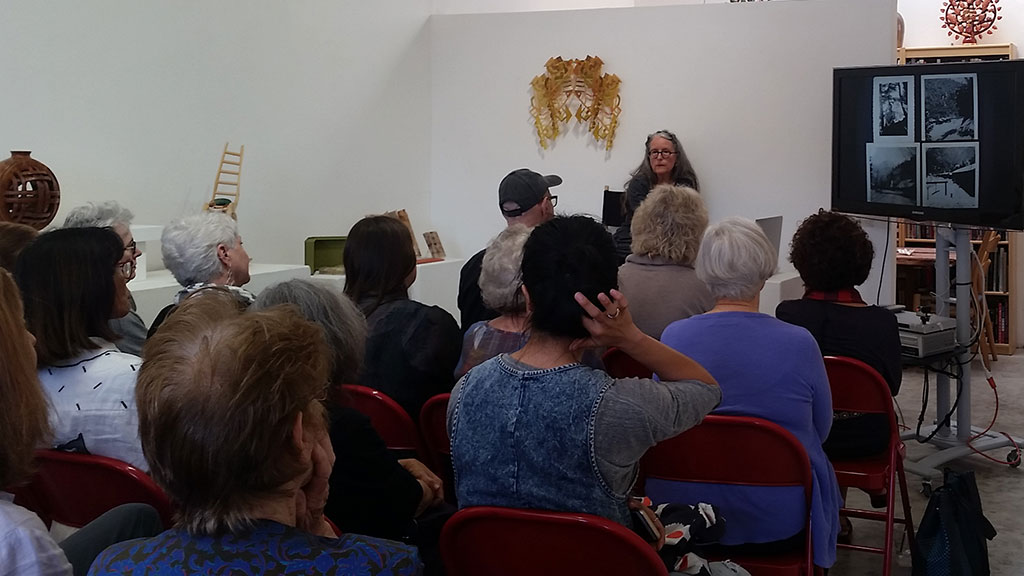
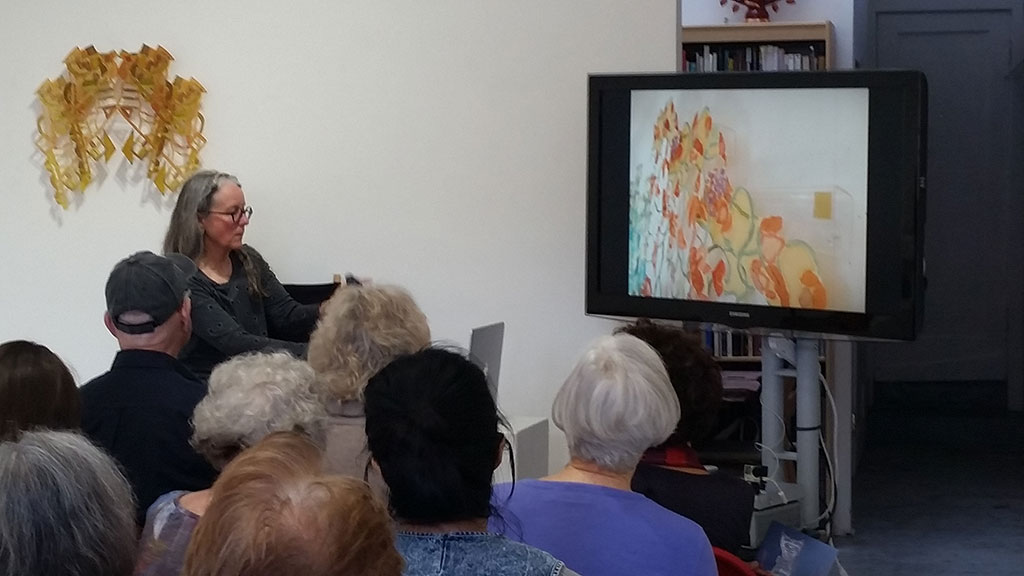
Joy Stocksdale’s textile interest came while in high school in 1965 with machine embroidery. After college she continued to work with and teach stitching, quilting and weaving. After returning to London in the 1980s, Joy began screen printing and dyeing. During her presentation the audience was enthralled with her specific process of polychromatic screen-printing. She had an image for every step of her dyeing and printing process, which allowed for us to view the outcomes and differences in the runs. As Joy’s talk continued, her work became much more elaborate. Joy showed us her fashionable tops and scarves, as well as her beautiful wall hangings.
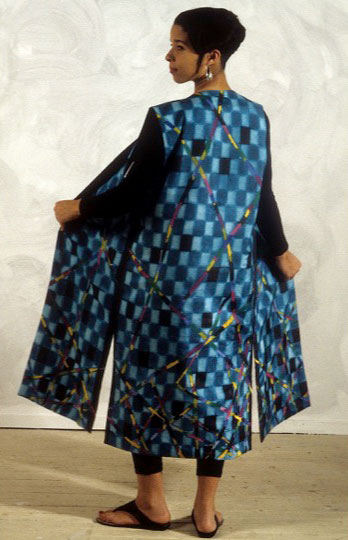
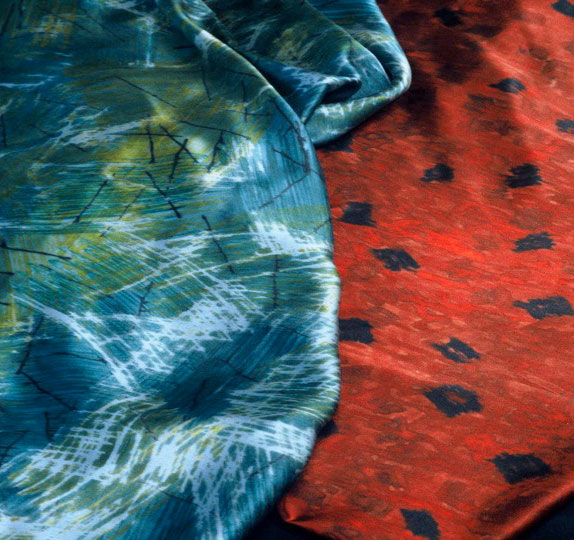
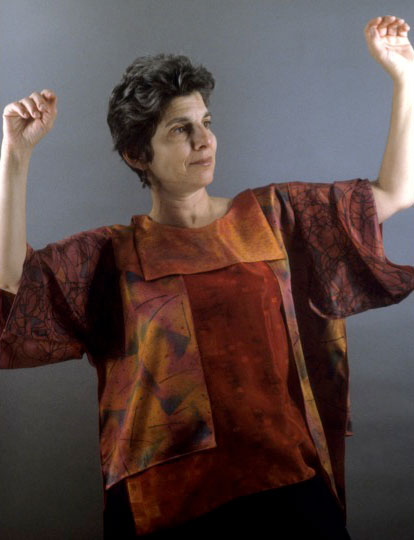
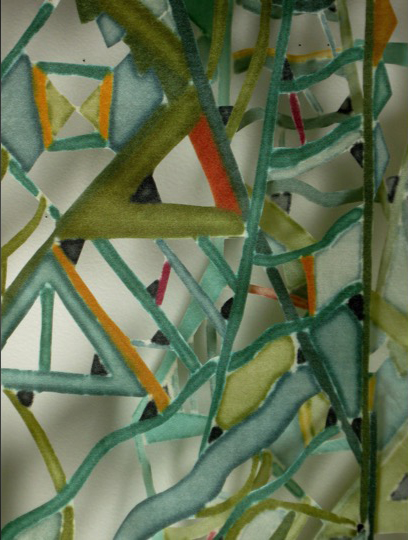
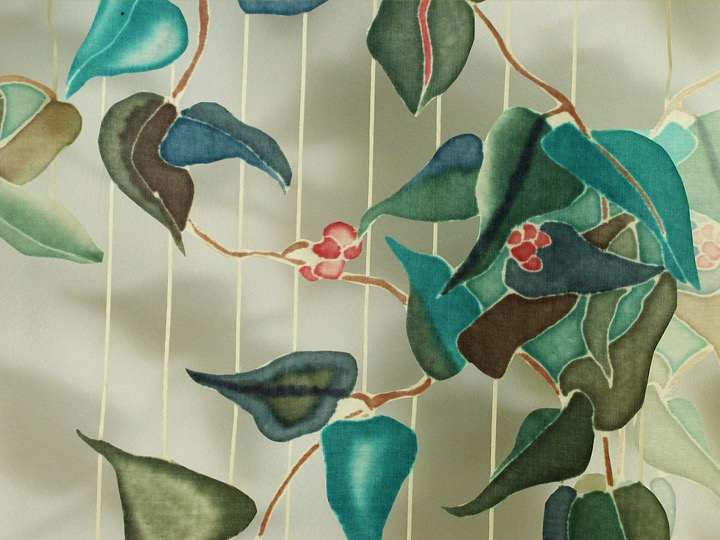
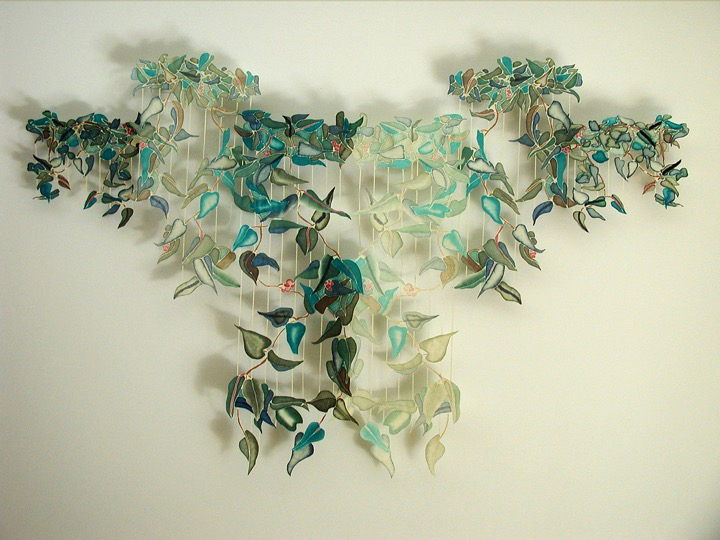
After her talk, visitors were invited to chat with the artist as well as go next door to Freehand to view more of her work on display. To understand the depth of Joy Stocksdale’s virtuosic ability is to understand that Joy’s skill was refined and transformed as each year, even decades, passed. She has exhibited her work nationally and internationally.
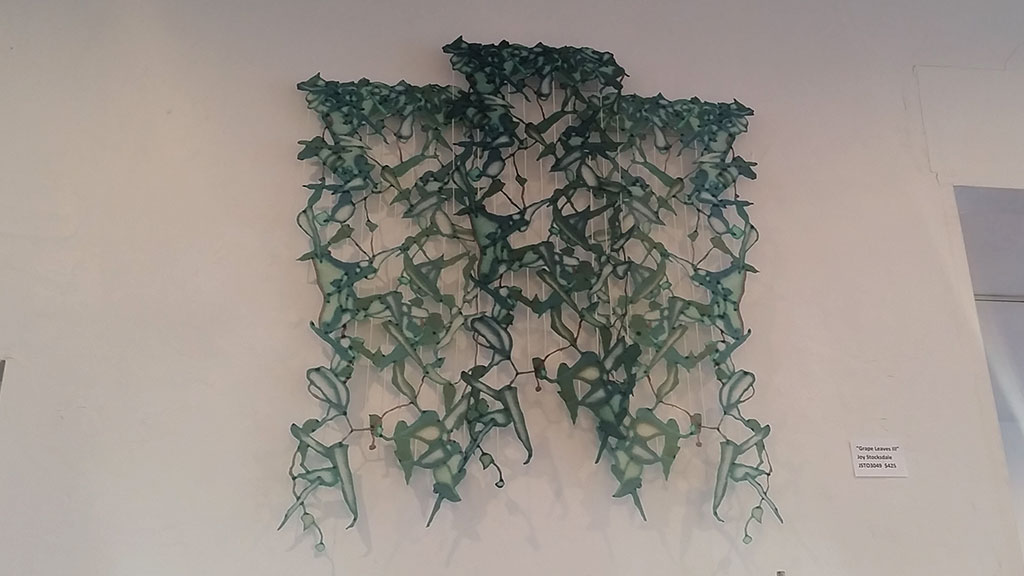
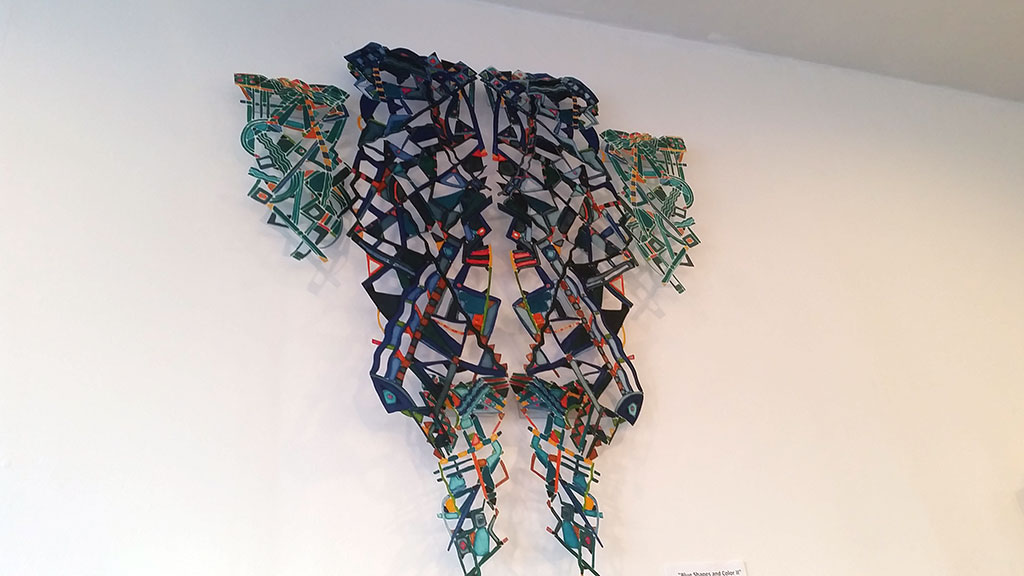
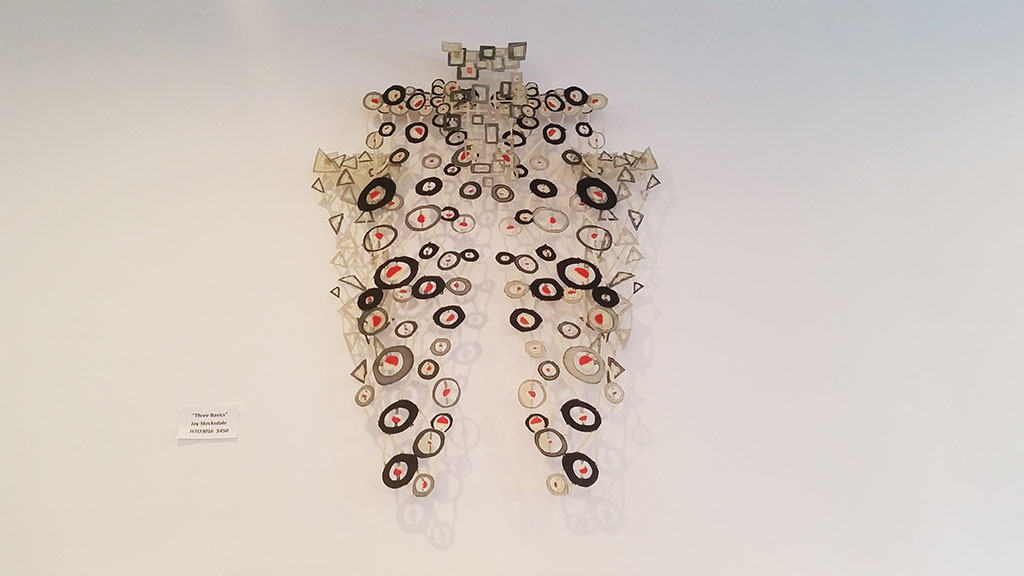
Dante Marioni at the Craft in America Center
“It’s a rare day that I show up someplace and get to just talk about myself–no dog and pony show.”
Dante Marioni spoke at the Craft in America Center on March 9th where he did just that: talked about himself with good humor and surprising candor. He also qualified his quote by saying, “If you don’t enjoy people watching you and being on display–you should probably do something different [than glassblowing].”
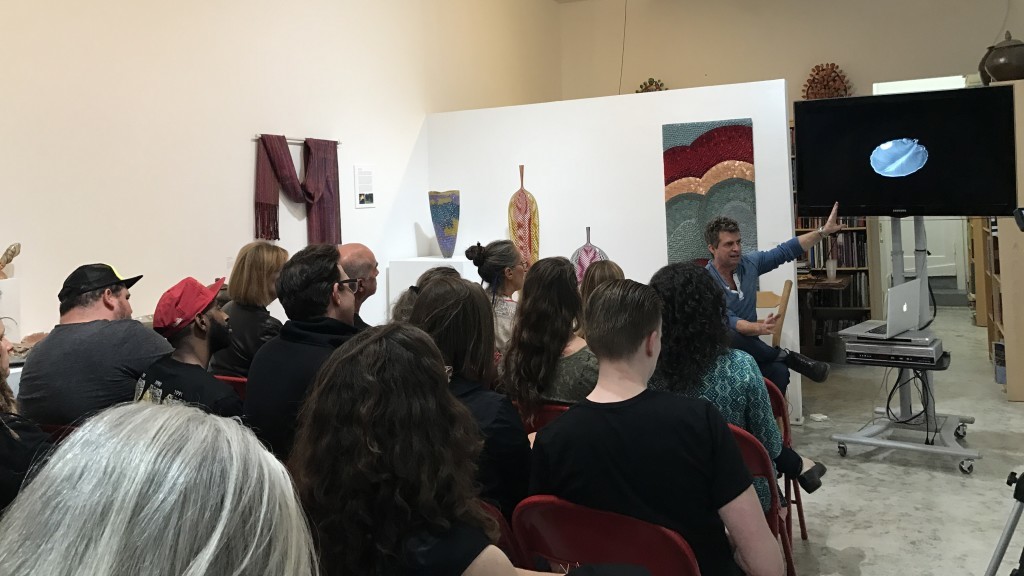
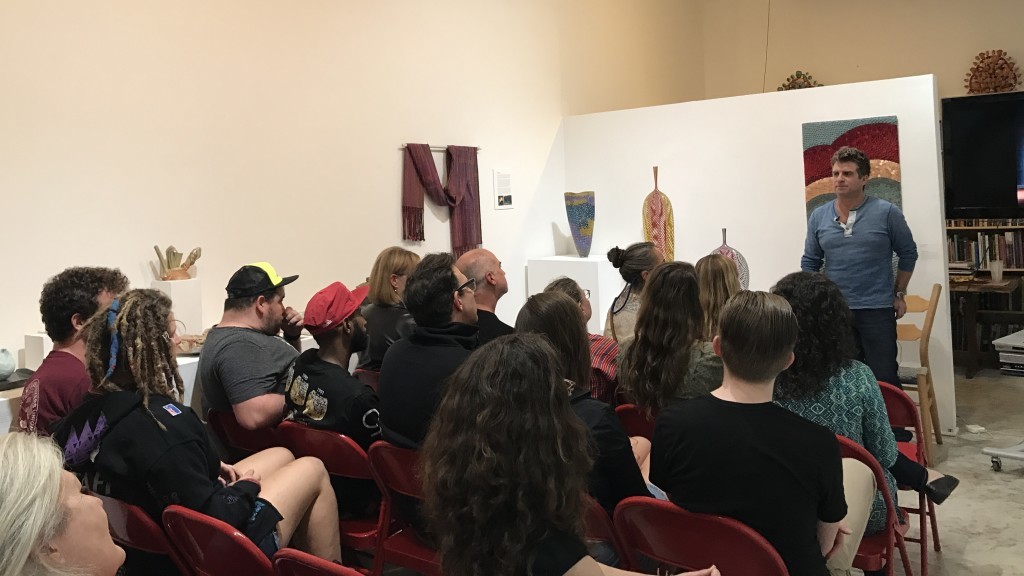
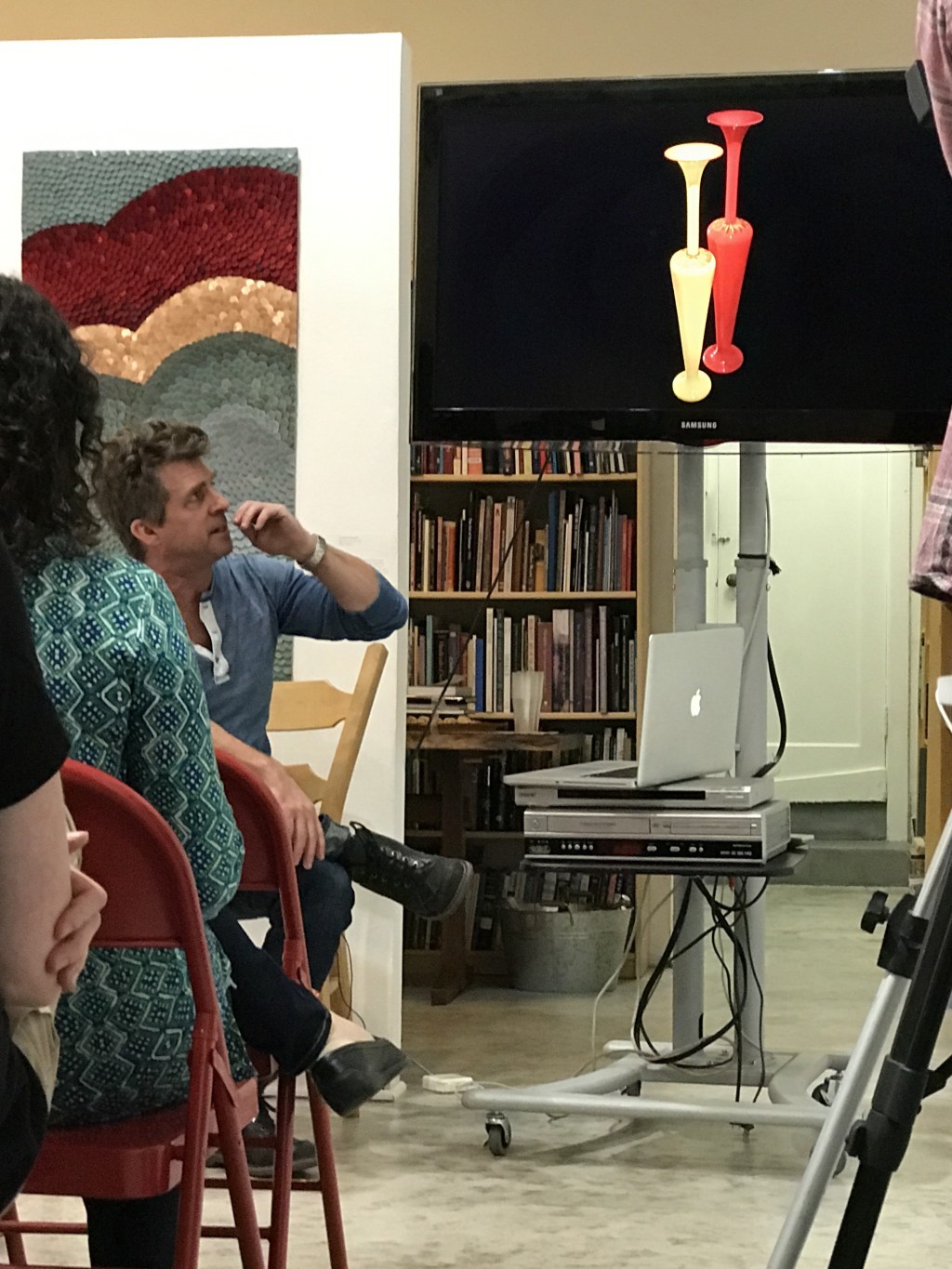
“I was lucky that at an early age I found what I wanted to do.” He started blowing glass for fun–seeing his father play with the medium really inspired him. Marioni spoke about his early career when he could really perfect his technique by making goblets–a right of passage for glassblowers. He described a “goofy chandelier” that was a gorgeous large-scale work that incorporated many, many goblets. He went back to visit it later and found that people had tossed coins in it, probably for good luck.
While inspired by the freedom the preceding generation was taking with glassblowing, Marioni got more interested in pattern; the mathematical precision of reticello was compelling to him. Encouraged by his dear friend Lino Tagliapietra, Marioni embraced the method with fantastic results. He mentioned that this talk would be “demystifying,” but in actuality, he clicked through numerous images of incredible feats of skill that remain stunning and remarkable.
“What I do, and a lot of people that blow glass, is process driven. You blow things and you see things that inform what you will do next,” Marioni said.
ARTIST TALK: JAYDAN MOORE
This past Saturday, artist Jaydan Moore gave an insightful talk at the Craft in America Center into his practice and the artists that inspire him. He took us on a journey through his past, coming from a family of third generation tombstone makers, to the many craft schools where he has studied. He kept the audience interested and laughing the entire presentation. Video of his presentation is available here.
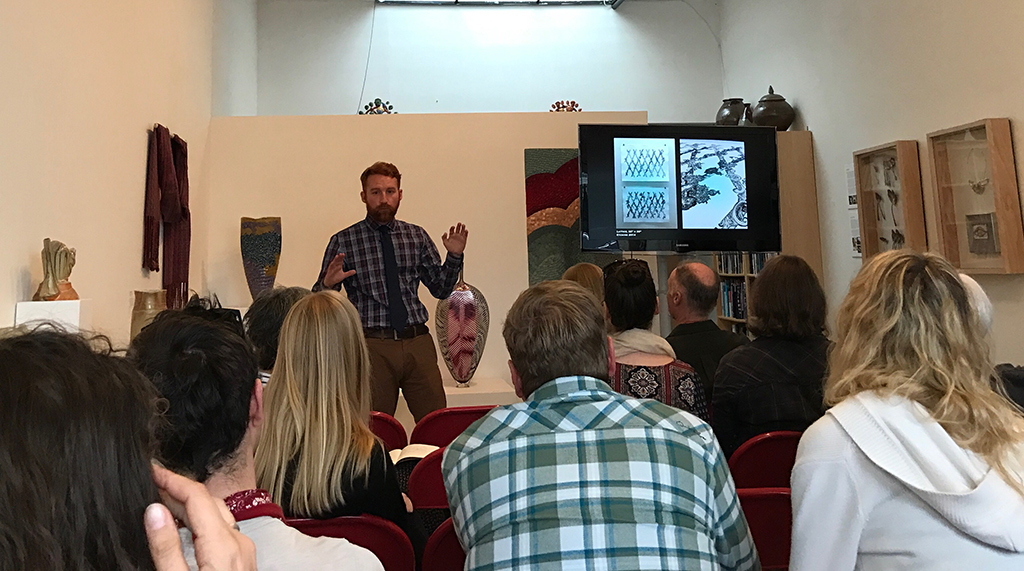
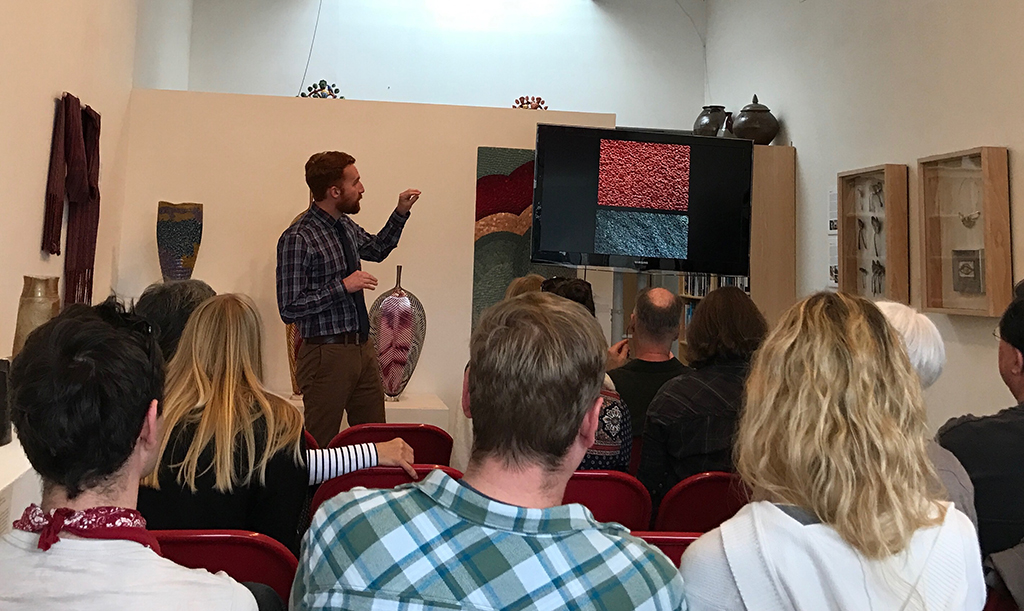
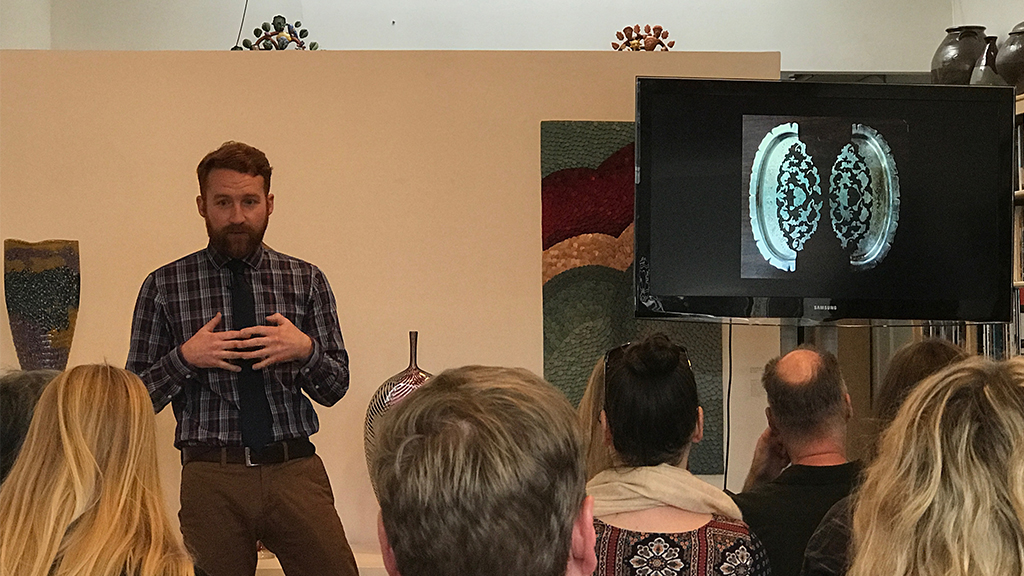
From an early age, he was interested in preservation and the objects that surround these memories. One of his first series emanated from trophies and their connection to retiring service industry professionals receiving teapots.This started him down a long path of using found objects and making them entirely new while sculpting with the “use” of previous owners. In keeping with his sense of humor, Moore told us, “The best part about making a show about trophies is that you get to take all the trophies home with you.”
Moore explained the material he starts with: the discarded and precious items of thrift store shops and specifically silver-plated platters. These mass-produced platters allude to the past, to the handcrafted sterling silver platters, teapots, and silverware that are on display in museums. Of the three layers that are present (the original metal, the silver-plating, and the layer left by use), he finds the personal-use layer the most enticing: the owners care (or lack of it), the cleaning and polishing that has worn off the plating. Moore uses these platters to juxtapose memories–to explore the different histories present. He calls this technique of putting pieces on top of each other and melding into an object, “marriage pieces.”
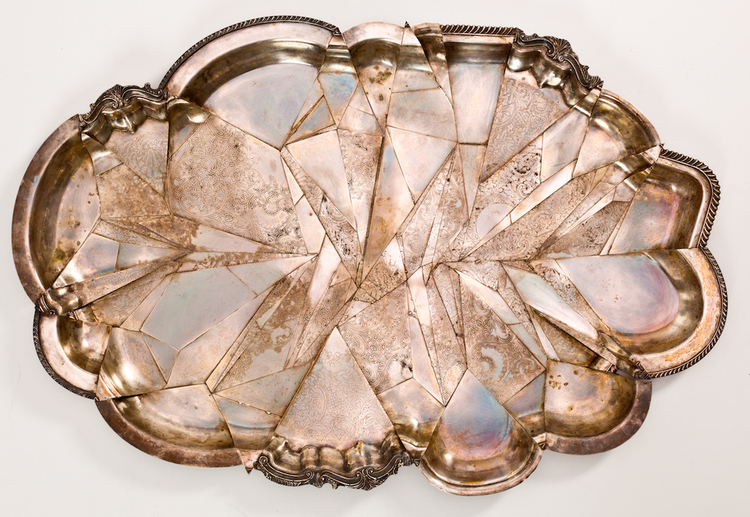
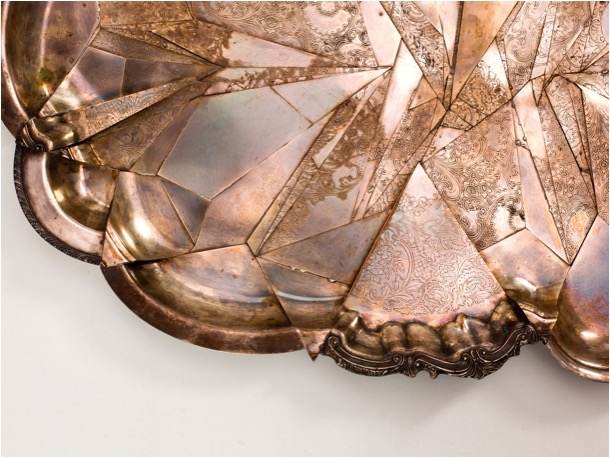
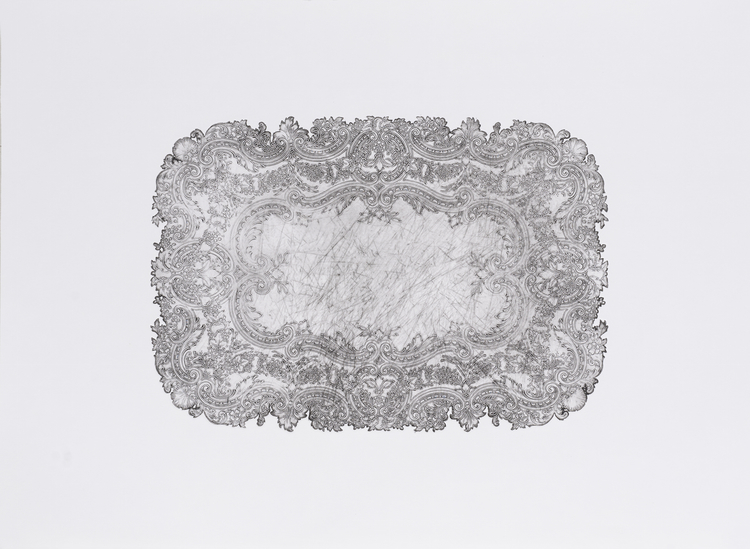
Moore uses low-heat soldering because, while he loves high-heat soldering, it would damage the patina too greatly. He works exclusively on the backs of the platters to keep his hand invisible. Moore accepts donations of platters and makes-single edition prints for the owner then uses the platter as material for his sculptures. “I’m going to destroy this thing,” Moore says, “I hope you’re OK with that.” Moore makes screen prints for all the platters he uses before he cuts them apart, and has begun printing with the synthesized pieces as well.
During the Q&A session, Moore was asked about advice on getting into craft schools; the artist said that–besides the mass amounts of work that needs to be produced to be considered–showing up is critical. The schools want to see that you are interested and you know where you will be living and working for potentially three years. Moore related that he almost didn’t get into Penland School of Crafts because he hadn’t been there. He is currently in his final year of his three-year residency at Penland. “The greatest thing about going to a craft school is that you get influenced by so many people there,” said Moore. “Many people get to show up for two weeks and get to experience a new technique, a new material.”
We look forward to seeing what this artist will come up with next.
ARTIST TALK: ARLINE FISCH
Last Saturday, the Craft in America Center was pleased to host a talk by the incomparable Arline Fisch, a luminary artist and true Living Treasure. This was a packed event and those who attended were not disappointed. Arline, who founded San Diego State University’s jewelry program, started her career, as she stated quite plainly by simply, “knocking on people’s doors to see who would allow her to work in their studio space.” Thanks to her sheer talent, conviction, curiosity and visionary versatility to float between metal and fiber work, many doors opened over the sixty odd years of her career.
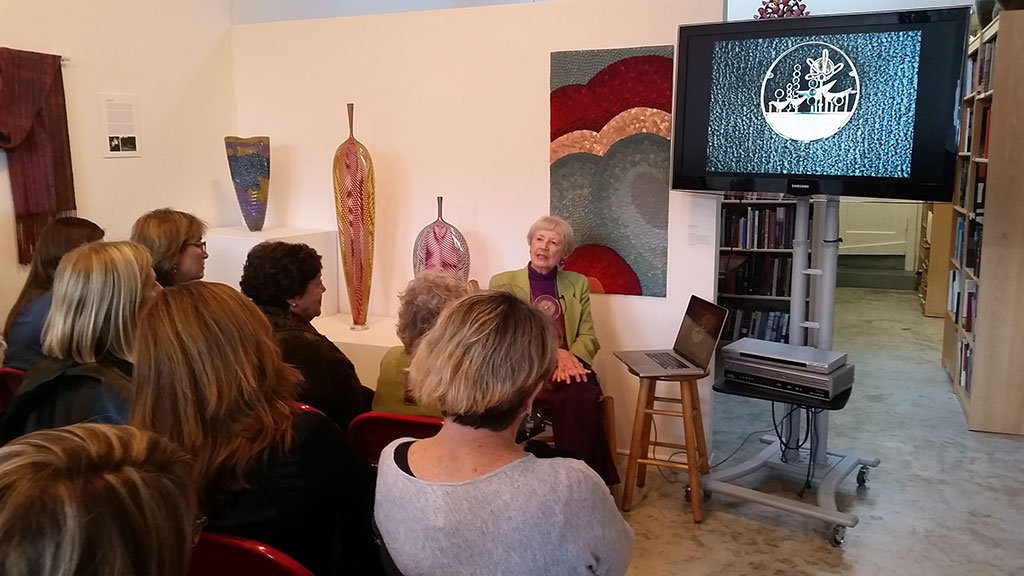
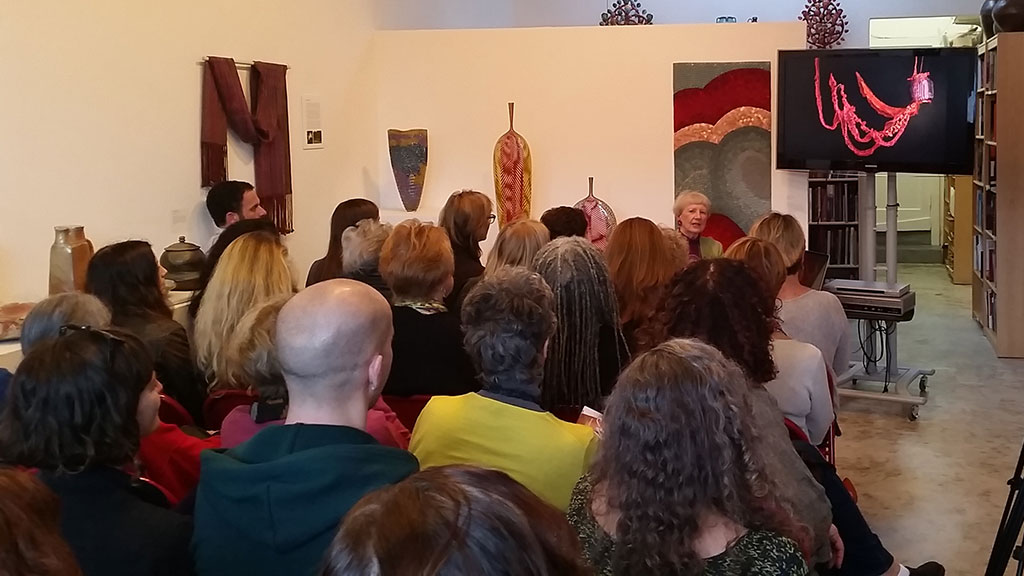
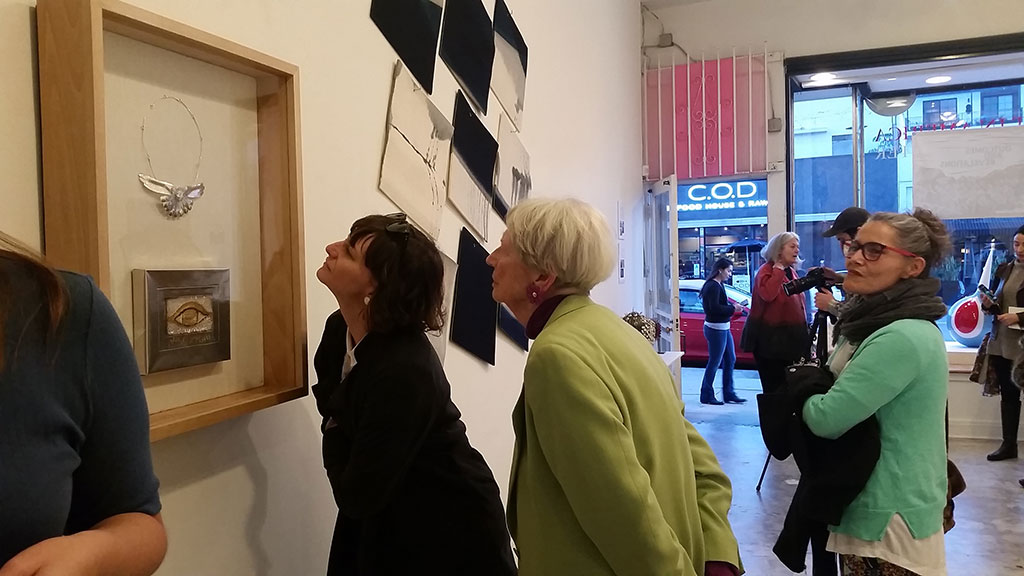
Arline spoke about how knitting metal wire on tubes helped her works become what they are in more recent decades, from neckpieces and bracelets to jellyfish. But something that struck many of us about her talk was how she explained that her work began through inspiration from Egyptian civilization and Latin American culture. This, she explains, is why she makes her powerful, bold neckpieces and not necklaces. Because her neckpieces are extremely lengthy, they often had to be balanced throughout the front and back of the body to weight out the difference.

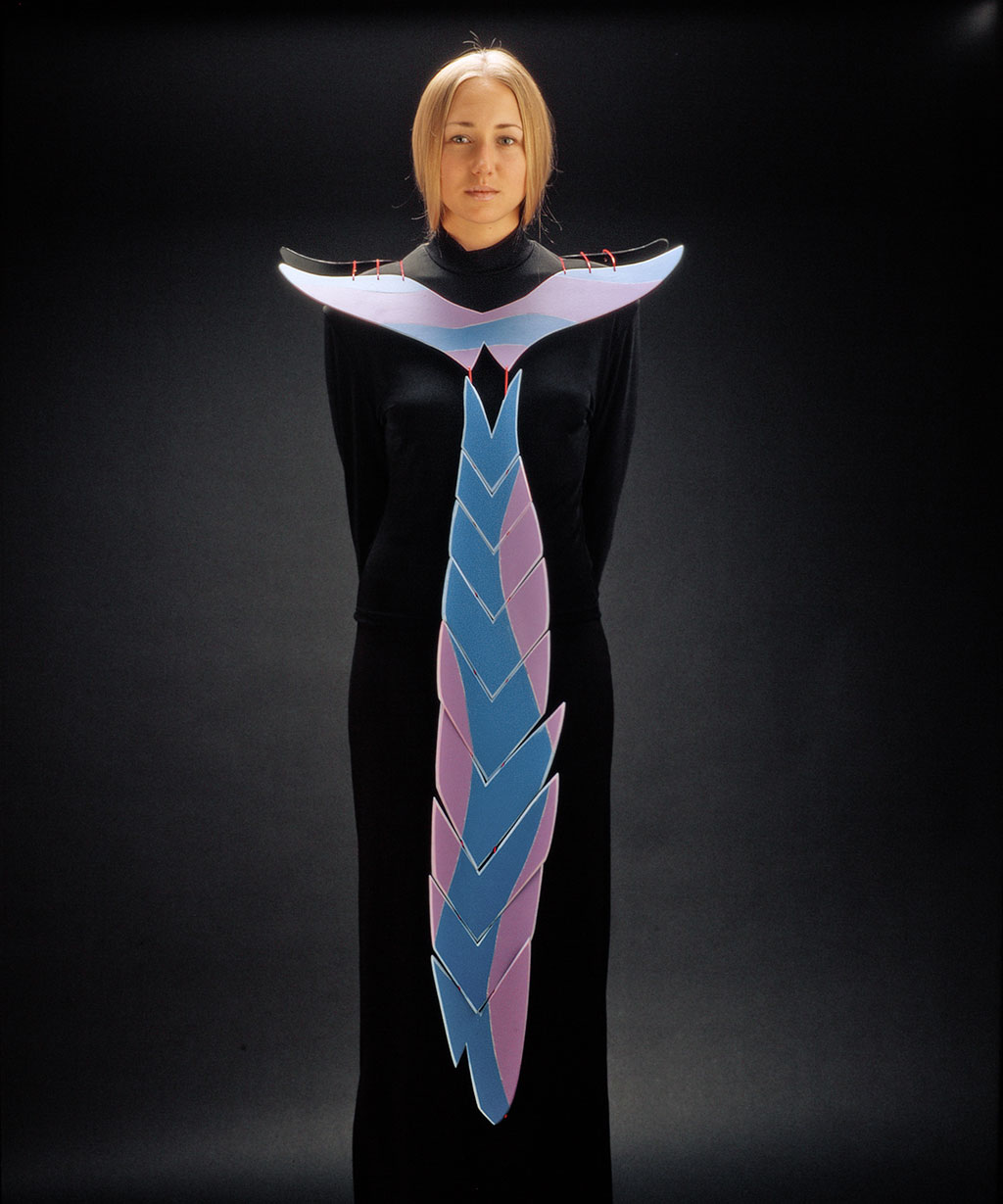
The images of her colored wire work were vibrant and left us wanting for more. Her progress through the years demonstrated a timeline of different techniques. We saw her earlier work, in which metal shapes were incorporated together to create singular works of beauty. Later, she created work that was made through braiding sheets of metal, creating a woven effect. This then led to some of her more vibrantly colored pieces, wherein Arline used thin-gauged wire to mimic the knitting process.
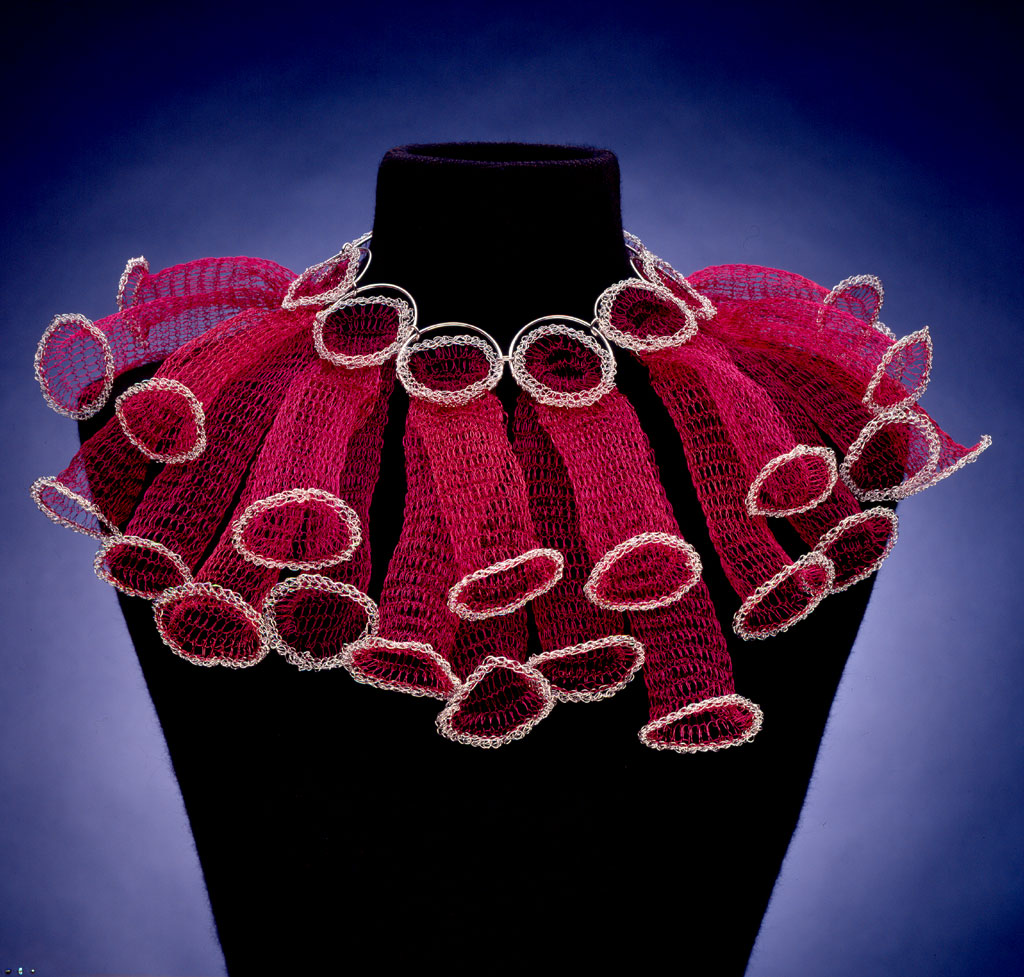
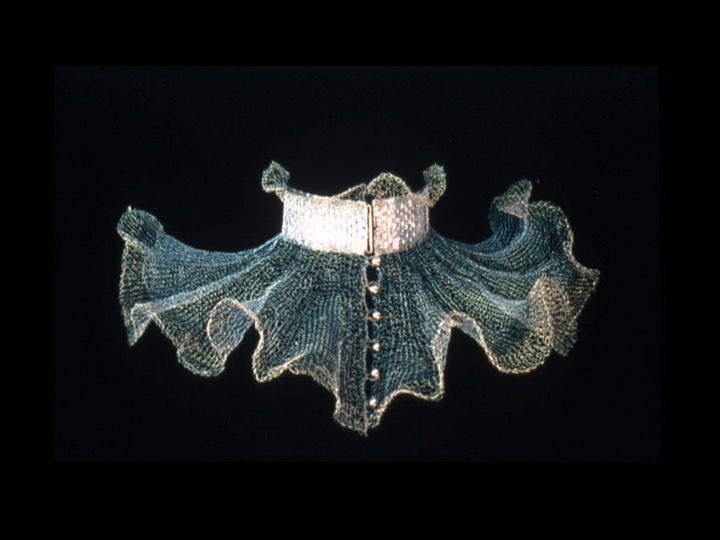
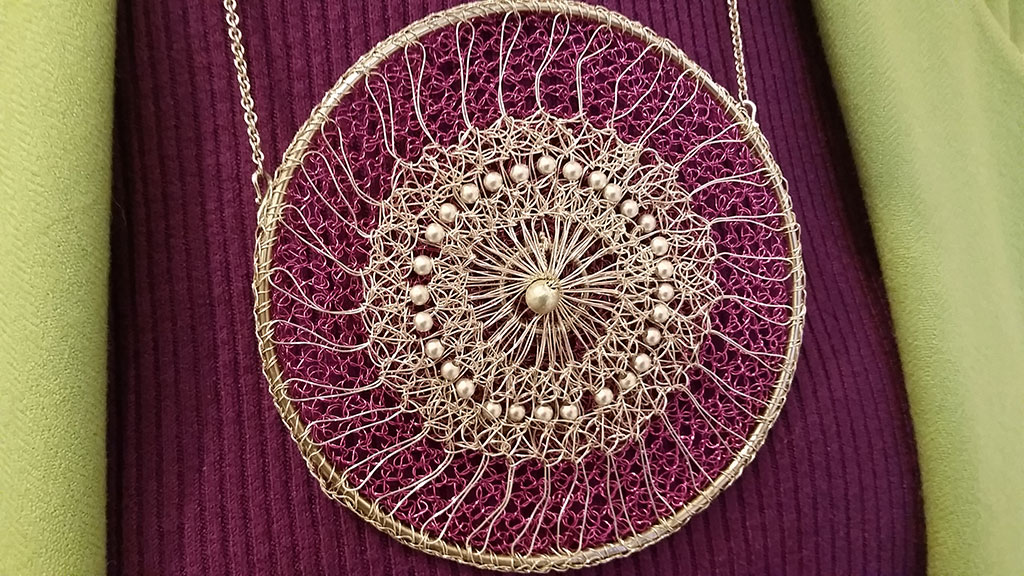
Arline’s talk gave us an intimate sense of how she developed certain methods over the years to create her jewelry. It was memorable, no doubt. We will post footage of her talk shortly so you all can have a chance to watch and learn from this legend.
Persuading the Public to Venture into a Craft School Experience
This past Saturday we had the privilege of hosting a talk with Penland School of Crafts’ Director Jean McLaughlin. It was a considerable turnout with people filling our space to learn more about “The Craft School Experience”. McLaughlin spoke about all five schools in our exhibition, Penland, Haystack, Arrowmont, Peters Valley, and Pilchuck, and how these schools have a special relationship that differentiates them from various other craft schools in the country.
The audience was eager to ask questions about registration, class size, demographics and tuition. We found out that each school is different in it’s own wonderful way. McLaughlin effortlessly made Penland sound enticing and encouraged everyone to look at the registration booklet to see the various types of classes offered per session. There are several classes offered each session, summer being the most popular, and they range from beginner to advanced levels. These are classes taught by talented and renowned artists. She provided information and gave ringing endorsements for courses being offered in 2017 at the other schools in the consortium, as well.
We followed the talk with a reception for our current exhibition “The Craft School Experience: Outcomes and Revelations.” Displayed are pieces by Cynthia Bringle, Nancy Callan, Sonya Clark, Bruce Dehnert, Arline Fisch, Susie Ganch, Matt Kelleher, Gerhardt Knodel, Marc Maiorana, Dante Marioni, Christy Matson, Sequoia Miller, Jaydan Moore, Rowland Ricketts, Chris Staley, and Lino Tagliapietra. All artists have taught, studied and/or worked at one or more of these craft schools. We are showing cross-disciplinary artists who have been vocal about the craft schools that have most impacted their work.
Don’t miss this collection of exceptional pieces by artists from across the craft spectrum. And, if you would like registration booklets for these schools, please feel free to stop by the Craft in America Center for your own free copy. The exhibition “The Craft School Experience: Outcomes and Revelations,” runs through March 11, 2017.
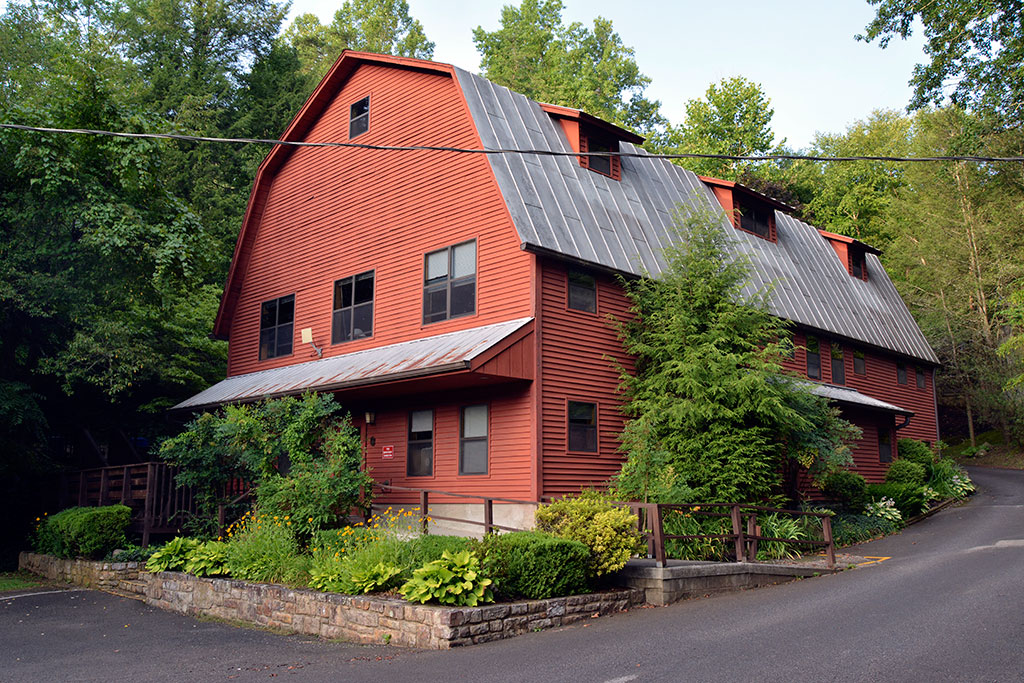
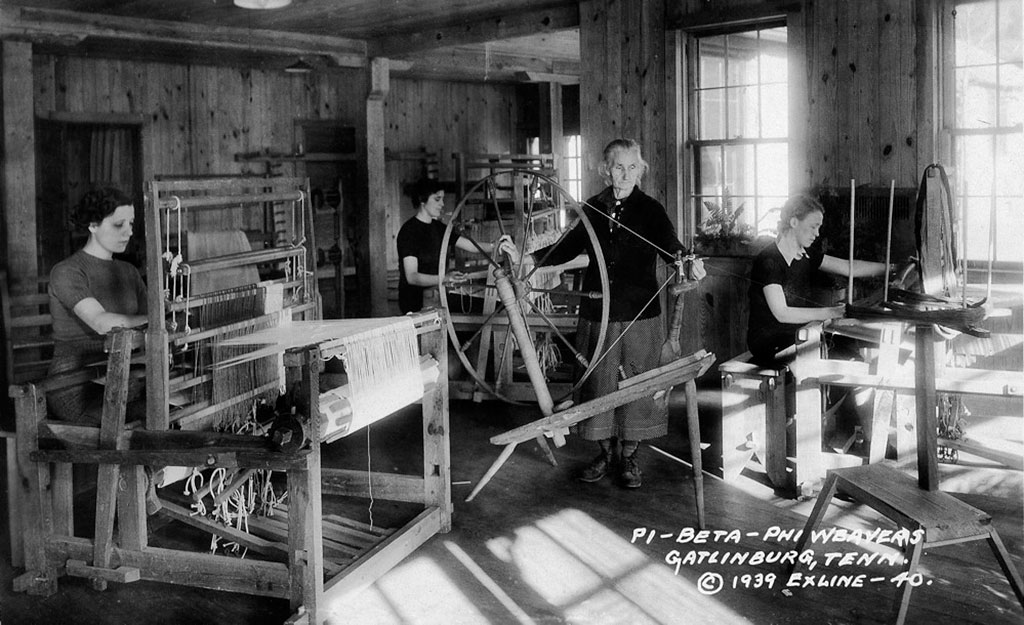
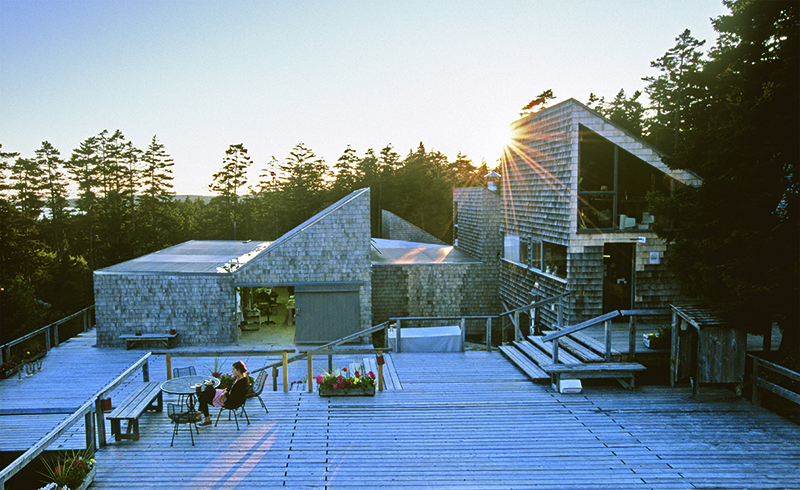

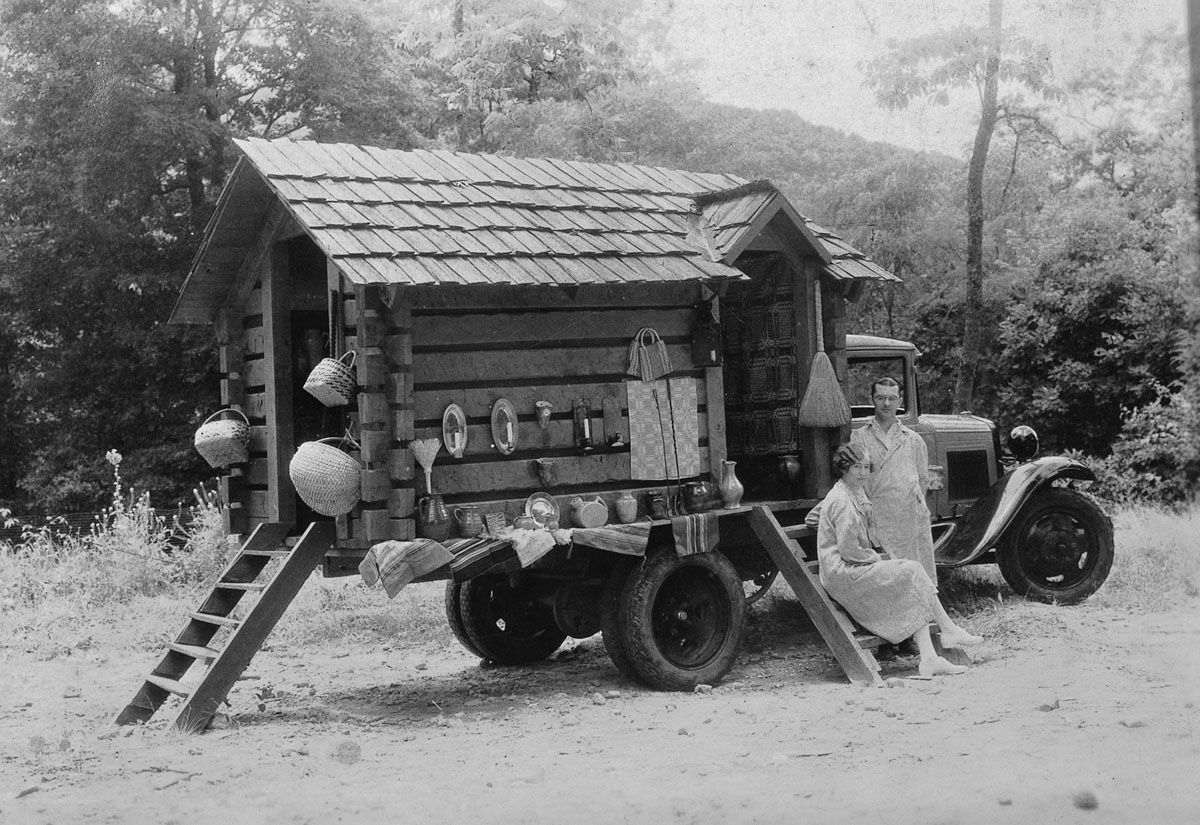

ARTIST TALK: SANDRA ENTERLINE
Sandra Enterline transformed the Center into a wonderfully crowded space during her talk on Saturday. Many visitors were fascinated by what she expressed about her oil-inspired jewelry pieces. She discussed the ability to encapsulate pieces from a place in time, a souvenir, and turn them into jewelry. Collecting nostalgic memories in the form of physical objects allows Sandra to transform these materials into wearable art. You can see samples of her work in Titusville Chandelier and San Agapito necklaces which hold petroleum the artist personally obtained from Drake Well in Titusville, Pennsylvania.
Following Sandra Enterline’s talk was the opening reception for Politically Speaking: New American Ideals in Contemporary Jewelry. We had many familiar faces in the crowd, including artist Christina Smith, whose work is also on display at the Center.
The exhibition runs through November 5, 2016 and features various wearable objects in red, white and blue, an acknowledgement of American politics. The jewelry on display brings to mind prominent topics that are affecting today’s political atmosphere. The detail and craft displayed in these pieces allow for small objects to hold loud and clear statements.
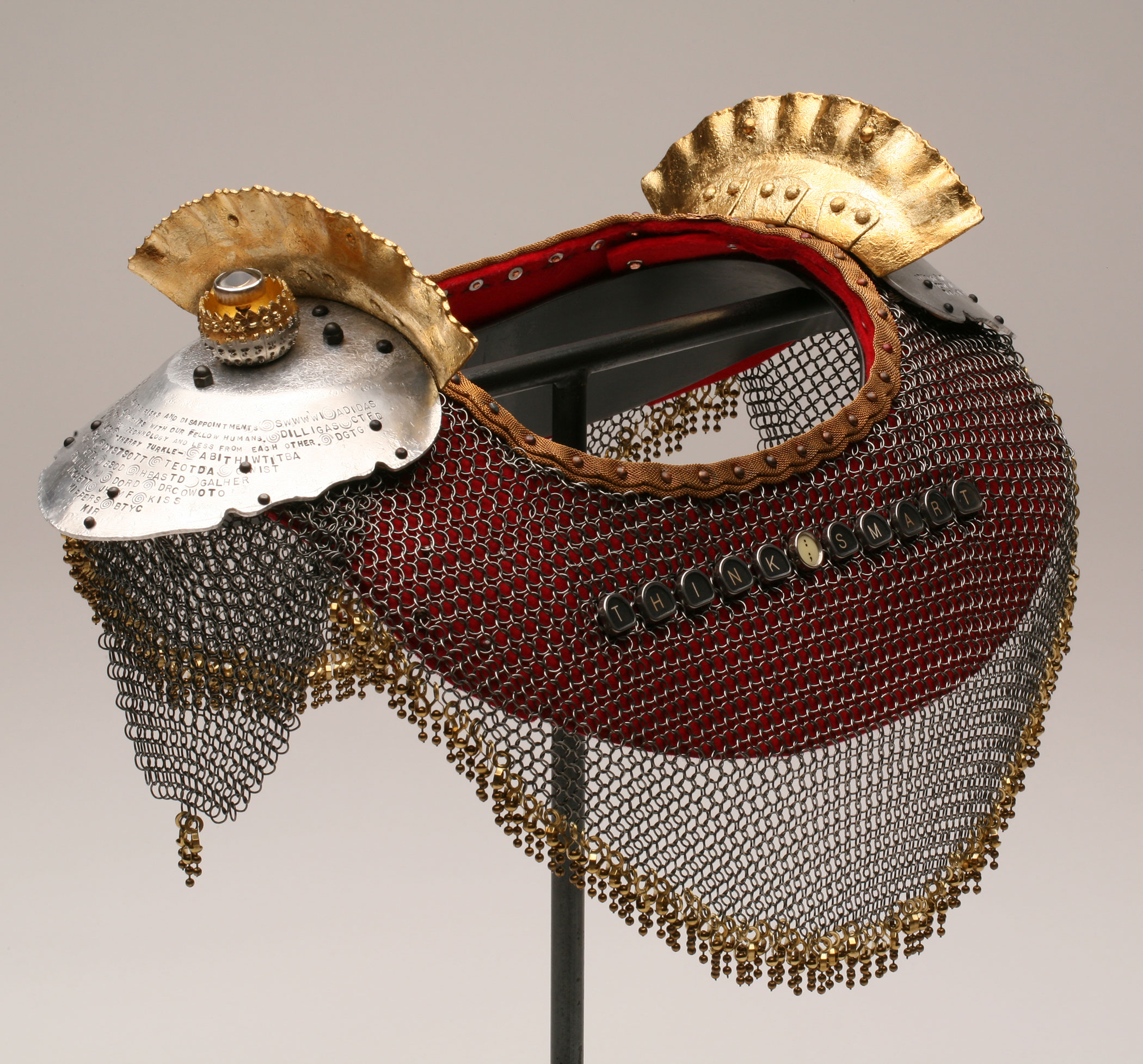

Sam Hilliard – Lighting Design in the New Market
Hilliard Lighting, whose founders are passing the torch on to their highly capable son, Sam, has been a luminary in the lighting industry for forty years. When they captured the attention of design company Kneedler Fauchere in the 1980s, the game changed for the artist couple who were making slump glass tile lamps and traveling them to American Craft Council shows across the country. Their business model shifted and they built a workshop in Arcata, CA that could accommodate the volume increase. The workmanship remained strong and that value is essential to their success story today, as is shown in a film Sam recently made about the company. Sam visited the Center on Saturday and talked about the unique nature of design showrooms and the place of craft in the interior design market.
See the short film on 40 Years of Hilliard Lamps
